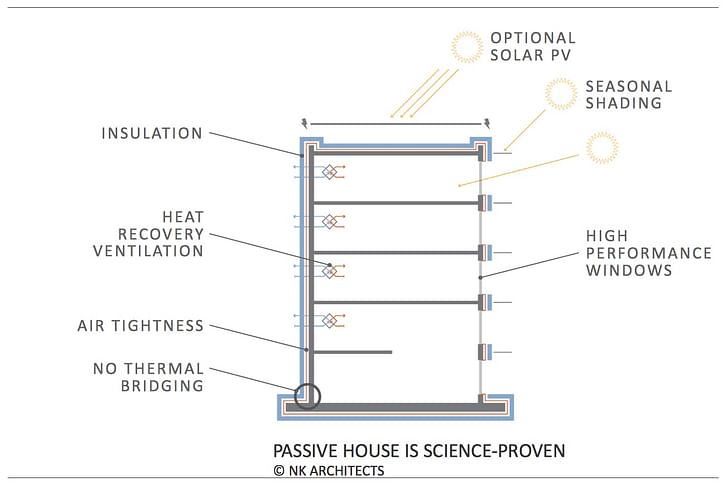

With reversals in US climate policy underway and a US exit from the Paris Agreement announced for 2020, it’s easy to lose sight of the fact that the clean energy transition is already underway. The potentially exponential forces of market transformation that this transition could release offer real, economics-based cause for hope for the future of the planet.
Dramatic cost reductions for solar and wind energy are already making renewable energy cheaper than fossil fuels in many parts of the US and the world. Falling battery and electric vehicle prices threaten the future of the internal combustion engine and of global oil demand. New grid storage facilities in California are competing with gas peaker plants. The world of energy in 2027 may look dramatically different from today.
The building sector is an oft-overlooked player in discussions of the clean energy transition. This is a mistake, as buildings are responsible for well over a third of greenhouse gas emissions in the U.S. More importantly, recent advances in the field of building science position buildings as a technology that can be optimized for performance and cost, much like the other clean technologies of wind, solar, batteries and electric vehicles. Designers and builders therefore have the opportunity to propel the clean energy transition forward.

The reason that the clean energy transition is happening—and the reason that it will continue to accelerate despite policy obstacles along the way—is that solar, wind, and storage are technology, not fuel. In technology, innovation and experience drive costs down. By contrast, in extractive industries like oil, gas, and coal, costs typically rise over time; the next barrel of oil or shovel-full of coal is harder and more expensive to extract than the last. Industry innovations like fracking or automation can reduce costs, but the fundamental, rising nature of extraction cost remains.
According to energy equity analyst Michael Parker of investment firm AllianceBernstein:
“We are now facing globally one energy market with two suppliers. One of those suppliers is technology-based with falling cost. The other supplier relies on extraction, which has a rising cost structure. Over time, the answer to the question of which supplier will prevail is a simple one.”
Parker calculates that if solar and battery storage fall in price by just 3% a year and the cost of electricity from fossil fuels increases by just 3% a year, by 2030 solar plus storage will cost half of fossil fuel-generated power. “It’s facile math,” Parker writes. “But once you accept that technologies get better over time and extractive industries get more expensive over time, the long, long-term outcome is obvious.”
A 3% decrease per year for solar and battery storage is likely conservative. According to investment firm Lazard, the levelized cost of energy for utility-scale solar dropped by a whopping 85% from 2009 to 2016 for an annual reduction rate of 23%. Wind dropped by 66% over the same period, for an annual reduction of 14%. McKinsey & Company reports that electric vehicle battery prices fell by 77% since 2010, an annual reduction of 22%.
Recognizing these trends, as well as the steady global trend toward greater energy efficiency, AllianceBernstein’s Parker predicts that by 2030: 1. a mass transition from conventional power plants to solar and storage will be underway; 2. inexpensive high performance electric vehicles will make up nearly 100% of new vehicle sales; and 3. that demand for fossil fuels will be in freefall. Is he right? There are powerful political forces lined up to attempt to slow progress, so it’s hard to say.
But could we be at an inflection point already? 2016 marked the third year in a row that the global economy has grown while emissions have not. Have emissions peaked? Moreover, in 2015 the world began adding more energy capacity from renewables than from all fossil fuels combined, according to Bloomberg New Energy Finance. Many analysts expect renewables to gain more and more share of this incremental energy supply. Fossil fuels will make up 0% of new energy supply by 2020 according to UK research firm Trusted Sources. “Global demand for fossil fuels will then start to fall, and this will have hugely disruptive impacts across the global energy system,” analyst Kingsmill Bond writes.

The clean energy transition is driven by learning. Learning empowers innovation in technology. Innovation improves performance and decreases cost of a technology. Better performance and cost accelerates adoption of the technology.
Most of us are familiar with Moore’s Law from the computer chip industry. It says that every two years or so the number of transistors that fit on a chip will double. This phenomenon has driven the exponential increase in computing power over the decades, as well as the precipitous fall in the cost of that power. It’s why the smartphones we carry in our pockets are as powerful as yesteryear’s supercomputers.
In the solar industry there is a similar law: Swanson’s Law, also known as a learning curve law. Swanson’s Law says that for every doubling of solar capacity installed around the world the price of solar panels will drop by 22%. Because global solar capacity has been doubling every two years fairly consistently for decades, the price impact of all this learning is staggering. Since 1977 the cost per watt of solar panels has declined by 99.6%, from $76/watt to just $0.30/watt.
Steep learning curve laws also apply to wind, batteries, and electric vehicles. Prices for clean energy are crashing down.
The genius of Passive House design (and other energy-efficient building approaches based on rigorous building science) is that it recognizes the building itself–its skeleton and skin–as a technology. Passive House innovation therefore improves both performance and cost, a la other clean energy technologies. Powered by modern building science, energy modeling, and an advanced analysis of the thermal properties of building structures, Passive House architecture sits squarely in the realm of information technology and science-based innovation. That is a potential game changer for buildings’ role in the clean energy transition.

Many Passive House projects today are approaching cost parity with conventional construction. Research by the Pembina Institute pegs the cost premium of Passive House in North America at 6% compared to conventional construction, but when project teams are compelled to innovate, through competition for example, that premium is already dropping toward zero.
For example, two years ago the Pennsylvania Housing Finance Agency (PHFA) added bonus points for Passive House as part of its decision making criteria for the award of Low Income Housing Tax Credits to affordable housing developers. Teams that incorporate Passive House design into their proposed buildings can earn an additional 10 points out of a 130-point total. The decision to pursue these bonus points is totally optional and the policy costs PHFA nothing. But the bonus opportunity sets up a competitive environment that rewards innovation in Passive House design.
That innovation is driving cost down. Of the projects proposed to PHFA under the new policy, 59 have been Passive House and 120 have been conventional. The average proposed construction budgets–numbers that are carefully vetted and highly scrutinized–were $171/sf for the Passive House projects and $168/sf for the conventional ones. That’s a cost delta of less than 2% for these buildings, ones that deliver revolutionary energy efficiency and improved thermal comfort and occupant health. This cost delta will no doubt shrink as practitioners learn from their projects and further optimize performance and cost: technological innovation at work.
When a significantly better product becomes available for little or no extra expense then mass adoption becomes possible. When Passive House buildings become commonplace–as they are in Europe and as is beginning in Vancouver, BC–then the negawatts “generated” by this stock of ultra-efficient buildings can help “power” the grid. Future electric vehicles will be “powered” by these Passive House negawatts.
As Climate Tracker Initiative points out, the path to climate security is through fossil fuel demand destruction. As we destroy demand for fossil fuels, the price for fossil fuels falls. This makes extraction a money-losing venture, so oil, gas, and coal stay in the ground.

The key question, then, is how can we accelerate this demand destruction? The good news is we have a suite of climate solutions that are mutually reinforcing and enjoy the kind of positive feedback loops that can drive exponential change:

Accelerating climate change threatens our future, so time is of the essence. Can we save the planet? We have a fighting chance if we harness the forces above to accelerate the transition away from fossil fuels. But how?
Remember Swanson’s Law? The virtuous circle of this learning-curve law did not happen on its own. It happened thanks to human action: tens of thousands—perhaps hundreds of thousands—of physicists, materials scientists, engineers, manufacturers, supply-chain experts, installers, marketers, and policymakers each making micro-innovations over time to deliver solar energy a little bit better and little bit cheaper.
The same applies to the technology of Passive House. Builders, designers, building-component manufacturers, developers, building owners, policy makers, and marketers are the innovators in this case. We’re the ones who will drive the improvements that decrease cost and increase deployment so that deeply energy-efficient building becomes the no-brainer choice in the market and buildings move from climate problem to climate solution.
If our purpose in sustainable design is to help save the planet, then we need to focus on meaningful carbon-reducing building solutions that are scalable.
We’ve got the building technology to make it happen, and our innovations will only make that technology more effective and low-cost. But we need to accelerate the effort. Now is the time for innovation and building as climate action. It’s time for architects to claim climate leadership. Trump can do little to stop us.
This article draws from Zack’ Semke's e-book, “On Buildings, Swans, and the Power of Arithmetic.”
Zack is Chief Marketing Officer at NK Architects, a Seattle and Pittsburgh-based architecture firm dedicated to accelerating the clean energy transition through zero carbon building design. He studied human biology, with a focus on human ecology, at Stanford University (BA, ’93). Since then ...
2 Comments
This is a good introduction to the intersection of buildings and energy, an industry in which many of us have been working for years to advance the concepts of energy efficient building, distributed energy resources, EV adoption, and more. As an architect working on energy efficiency programs, I appreciate any opportunity to educate the larger architecture community on these concepts!
Great, timely article. Passive House is no longer a fringe concept. Its being proven feasible in the US on projects of multiple scales & types by a growing number of architects & engineers.
A recently completed study in the New York City context is highly relevant and supports PHFA's finding that Passive House level energy reduction is achievable and affordable now. The study shows how a tall multi-family residential building can be designed to meet the Passive House standard in a relatively normal way with only 2.4% additional cost. Lets make a new normal!
(Link to Study by FXFOWLE for NYSERDA)
Block this user
Are you sure you want to block this user and hide all related comments throughout the site?
Archinect
This is your first comment on Archinect. Your comment will be visible once approved.